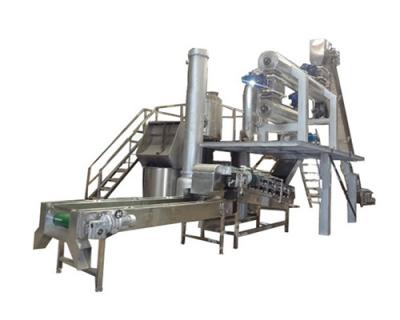Operation points of grape juice production line of Weineng m
Time:2021-04-07 13:25 Browse:277
Operation points of Jingjiang Weineng mechanical grape juice production line
Raw materials: choose fresh and mature red grape fruit, no mildew, deterioration and other mixed fruit mixed with it.
Feeding: put the qualified raw materials into the material pool with water transport facilities to facilitate the flow and reduce the damage of grapes.
Cleaning: clean the dust, mud, microorganism and other impurities on the surface of raw materials, clean according to the drinking water standard, and ensure the hygiene requirements of the process.
Selection: remove impurities, secondary fruits and rotten fruits from fruits and vegetables.
5 remove the grape stem: remove the grape stem to avoid the tannin in the grape stem entering into the juice, causing adverse effects on the quality, and pre crush the grape for convenient transportation.
6 Crushing and pulping: according to the process requirements, the raw materials are crushed into medium size (less than 2 times) particles, which is conducive to the extraction of grape skin pigment and the exudation of plasma cell fluid, and ensures the juice yield in the process of juicing.
7 separation and removal of seeds: the separation and removal of grape seeds in the pulp is conducive to the quality of juice products and the comprehensive utilization of grape seeds, reducing the cost.
8 preheat: through direct steam heating, grape skin pigment completely dissolved, pulp juice exudation, improve juice yield.
9 centrifugal pressing: according to the principle of the weight difference between solid phase and liquid phase, the solid-liquid phase is separated from the ventricle by high-speed rotation, and the residue is discharged by the long diameter screw of the centrifuge to obtain the clarified juice. This is a kind of equipment especially suitable for the pressing of pulp juice, which has the characteristics of large output, high degree of filtration automation and convenient operation.
10 Heating and cooling: using hot water as the heating medium, the microorganisms and enzymes in the juice are heated and passivated through the casing heat exchanger, so that the protein, starch and other substances are fully aged, which is conducive to the stability of the effective components of the juice and the enzyme activity in the follow-up process.
11Enzymatic method: pectinase, protease and cellulase are used to decompose the colloid formed by pectin, protein, starch and other substances in grape juice, so as to promote the filtration of ultrafiltration process, which is conducive to the stability of products.
12 Ultrafiltration: through the polymer ultrafiltration membrane filtration, intercept and remove the turbid impurities and miscellaneous bacteria in liquid substances. Polymer tubular ultrafiltration membrane is a new type of advanced membrane equipment because of its uniform pore size distribution, high strength, high flux and good durability. The juice after filtration is transparent and bright in color, which is superior to other filtration technologies.
13Vacuum concentration: the multi effect falling film concentration evaporator is used for low-temperature vacuum evaporation to remove the water in the liquid material, so that the effective components of the material can reach 5 times of the original juice concentration (65 ± 1 ° Brix), which is convenient for packaging, storage, transportation and preservation.
14Precision filtration: through concentration treatment or pipeline equipment, the particles in concentrated materials are filtered out to make the products clearer and more transparent.
15Sterilization: using hot water as the heating medium to kill all kinds of microorganisms in fruit juice by heating, so as to ensure that the product quality meets the hygienic requirements specified in the standard, which is the key point of quality control in this process.
16 packaging: the sterilized liquid is packaged into aseptic bags in aseptic environment by barrel packaging machine, which is convenient for storage, transportation and quality assurance.
17 inspection: according to the requirements of the standard, the sensory, soluble solids, total acid, light transmittance, color value and microbial indicators of the products are randomly sampled and tested during and after packaging. All meet the requirements before entering the warehouse.
18 finished products: all indicators meet the requirements before entering the cold storage as finished products.


